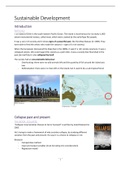Sustainable Development
Introduction
RAPA NUI
= an island of Chile in the south-eastern Pacific Ocean. The island is most famous for its nearly 1,000
extant monumental statues, called moai, which were created by the early Rapa Nui people.
It was a very rich society and it shows signs of a powerful past, like the Moai Statues (in 1500). They
were able to feed the artists who made the statues (-> signs of a rich society).
When the Europeans discovered the Rapa Nui in the 1800s, it wasn’t a rich society anymore. It was a
collapsed society. We could regard this society as a petri dish, it was a society that flourished in the
past (by itself) but it also collapsed by itself.
The society had an unsustainable behaviour:
- Overhunting: there were no wild animals left and the quantity of fish around the island was
low
- Deforestation: there were no trees left on the island, but it used to be a sub-tropical forest
Moai Statues
Polynesian Triangle
Collapse past and present
THE BOOK: COLLAPSE
“Collapse: How Societies Choose to Fail or Succeed” is written by Jared Diamond in
2005.
He’s trying to make a framework of why societies collapse, by studying different
societies from the past and present. He says it is a choice to collapse or not.
Research
- Comparative method
- Input and output variables (must be taking into consideration)
- Regression model
1
,He has come up with a 5-point framework (five factors that contribute to collapse):
1. Climate change
→ Due natural factors
2. Hostile neighbours
→ They might overthrow/harm you
3. Collapse of essential trading partners
4. Environmental problems
→ By example; overhunting, deforestation, …
5. Failure to adapt to environmental issues
→ If you fail to adapt, you are not flexible enough to avoid disastrous consequences
It is almost always a combination of those factors.
The most underlying reason (the reason that drives all these factors) is the overpopulation relative
to the practicable carrying capacity. It would be absurd to claim that environmental damage must be
a major factor in all collapses ... It's obviously true that military or economic factors alone may
suffice.
TED TALK: (http://www.ted.com/talks/jared_diamond_on_why_societies_collapse.html)
Some societies are more fragile to collapse than others. But why? There is no one-sided answer for
that question. He illustrates the 5-point framework by the extinction of the Greenland-Nords society
1. The human impacts on the environment: deforestation, gaining iron, …
2. Climate change
3. Relations with friendly neighbours: they traded with Norway, but Norway got weaker
4. Relations with hard style societies
5. The political and economic factors
KEEPING SYSTEMS IN BALANCE
= the main lesson from Diamonds book
We must consider the relationships between humans and their natural environment; the relation is
one of give and take. The sustainability concerns, in a present way (it is not new). We need to make
the reflection of how keeping systems in balance.
HOW ARE WE DOING?
“The world economy performed better in the last
half century than at any time in the past. World GDP
increased sixfold from 1950 to 1998 with an
average growth of 3,9% a year, compared with 1,6%
from 1820 to 1950 and 0,3% from 1500 to 1820”
In terms of GDP we are a thriving (= bloeiend) a
richer society than ever.
The GDP/capita has experienced strong growth since the second world war.
2
, There has been a large increase in
global population.
The first millennium versus the second millennium
Other findings:
- increases in global life expectancy at birth
- social revolutions (women rights, workers’ rights, …)
- information age
- multiplication of possibilities / choices
- globalisation
The elephant-curve
It displays the income increase of different
groups in societies (y) and the position of
different people the global income
distribution (x).
The poor people are on the left and the
rich people are on the right.
- - - - - - - = the average growth rate (25%)
For a group of richer people in 1988 the
income increases had been relatively low,
10% or even less. Mostly in developed
countries.
On average, there has been an increase!
3
, The life expectancy at birth is going up.
There is an increase since the end of
WOI.
CLOUDS ON THE HORIZON
“If everyone used energy and resources the same way we do in the Western World, we need three
more earths at least. And we have only one.”
➔ Refers to the huge ecological footprint & the overshoot of the western worlds
Other clouds on the horizon:
- large inequalities, both on a national and a global scale
- not only economic inequalities; also access to water and sanitation, energy, health care,
education, ...
- developing countries versus developed countries
- growing population = increased impact on the environment
- resources and waste sinks
- climate change (not the natural climate change)
- ethical aspect
- important to keep systems in balance!
Ecological Footprint (Rees &
Wackernagel)
= a metric that allows us to calculate
human pressure on the planet, it
accounts for resource and land use,
waste absorption, energy
production, ...
Today, humanity uses the equivalent
of 1.5 planets to provide the
resources we use and absorb our
waste. This is referred to as “global
ecological overshoot”, depleting the
very resources on which human life
and biodiversity depend.
Earth Overshoot Day 2018 = August
1st (2017/2016/2015: August
2nd/8th/13th). In 2020 was it on
august 22nd, due the pandemic.
----- = 1 planet line
4




